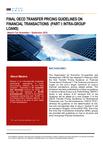
Final OECD Transfer Pricing Guidelines on Financial Transactions (Part I: Intra-Group Loans)
STRUCTURE OF THE GUIDANCE
The Guidance is divided into five main sections. These are:
- Accurate delineation of the transactions;
- Treasury function, including related transactions such as intra-group loans, cash pooling and hedging;
- Guarantees;
- Captive insurance; and
- Risk-free and risk-adjusted rates of return
DETAILED ANALYSIS
In this newsletter, we will focus on accurate delineation of the transactions and intra-group loans. The discussion on treasury functions would be covered in Part II.
1. ACCURATE DELINEATION OF THE ACTUAL TRANSACTION
Before the introduction of the Guidance, transfer pricing analysis on loans would generally focus only on the price. The Guidance requires taxpayers to first determine whether an intra-group loan is in substance a loan or equity or a mix. The taxpayers would then have to consider whether the loan should be re-characterized into a contribution as equity from a tax perspective.
Based on the facts and assumptions, it can be concluded that Company A would not be able to service the ten-year term loan and that an unrelated party would not be willing to provide such a ten- year term loan to Company B. A big portion of the loan should be re-classified as an equity investment by Company A. On the other hand, in the second scenario, it is very likely that the revolving loan would be considered as a loan.
1A. Commercial or financial relations
The accurate delineation of the financial transaction requires an analysis of the factors affecting the performance of businesses in the industry sector in which the MNE group operates. These factors include the business cycle, the product cycle, effect of government regulations and availability of financial resources.
It also considers how the MNE group responds to the identified factors. In this regard, the information provided in the MNE group’s policy includes the funding needs between the various entities, among different projects, strategic significance of a particular MNE within the MNE group, specific credit rating or debt-equity ratio and the different funding strategies than the one observed in the industry sector.
For example, an MNE group identifies its subsidiary in the UK as the European headquarters. Even though the UK subsidiary is one of the many subsidiaries in Europe, its consideration of the specific credit rating or debt-equity ratio may suggest that the UK subsidiary be funded with equity rather than as loan. If the MNE group structures the funding of the UK subsidiary as loan, it could be re-characterized as equity.
1B. The economically relevant characteristics of actual financial transactions
The following economically relevant characteristics of actual financial transactions should be considered when analyzing the terms and conditions of a financial transaction:
- Contractual terms;
- Functional analysis;
- Characteristics of financial instruments;
- Economic circumstances; and
- Business strategies.
Regarding contractual arrangements, the Guidance stipulates that terms and conditions of written agreements and other documents should be considered, as well as the actual conduct of the parties and the economic principles that generally govern relationships between independent parties in comparable circumstances.
A functional analysis is necessary when accurately delineating the actual transaction. With regards to the functional analysis, an overview is provided on typical key functions performed by lenders and borrowers in connection with intra-group loans. The Guidance highlighted that a related party lender may not perform all the functions at the same intensity as an independent lender. However, the Guidance further stipulates that when the lender is not exercising control over the risks associated to an advance of funds or does not have the financial capacity to assume the risks, such risks should be allocated to the enterprise exercising control and having the financial capacity to assume the risk. For example, if an intermediary company is used to be the lender, in order for the intermediary company to be considered as the true lender, it must be the one exercising control over the risks and would also have the financial capacity to assume the risk.
Characteristics of financial instruments include features and attributes such as amount of the loan, its maturity, the schedule of repayment, whereby these features and attributes should be documented properly.
The price of financial instruments may vary significantly on the basis the underlying economic circumstances including macroeconomic trends such as central bank lending rates, different currencies, geographic locations, local regulations, and timing of the financial transactions.
Examples of relevant business strategies listed in the Guidance include expansion (mergers or acquisitions) versus steady operations, the MNE group’s global financing policies, pre-existing loans and shareholder interests.
2. INTRA-GROUP LOANS
As discussed above, once a financial transaction is accurately delineated, and the loan is accurately identified as a loan, the taxpayer must then determine the arm’s length treatment of various financial transactions among related parties, i.e., intra-group loans.
When analyzing the commercial and financial relations as well as the economically relevant characteristics of intra-group financial transactions, the perspective of both the lender and the borrower should be considered. With respect to the lender, it is important for the lender to evaluate the lender’s decision to grant the loan, the loan amount and terms, various other factors and the options realistically available. The borrower will need to carry out an assessment of the need for additional funds to meet its operational requirements and options realistically available for the borrower.
This could be done by means of a credit assessment that is often required in the Transfer Pricing Documentation relating to intra-group loans. A credit assessment is normally conducted to identify and evaluate the risks involved and to consider methods of monitoring and managing these risks when a loan transaction is entered. The credit assessment includes understanding the business, purpose of the loan, how it is to be structured and the source of its repayment. Hence, commercial considerations such as creditworthiness, credit risk and economic circumstances should be considered when the loan transaction is assessed, along with the following factors.
Use of credit ratings
The Guidance acknowledges that the creditworthiness of the borrower is one of the main factors considered by independent lenders whereby the credit rating of an entity is used to measure the creditworthiness of the entity. The credit rating of an entity would be analyzed and benchmarked based on quantitative and qualitative factors and can be determined by reference to the overall creditworthiness of the MNE group to which the entity belongs to, or on a stand -alone basis. It is important for an entity to document the reasons and selection of the credit rating used.
Effects of group membership
The effect of group membership would have an impact on the credit rating of the entity. Firstly, the external funding policies and practices of the group management will assist in determining whether the form, terms and conditions of the loan are similar to those that the MNE would have entered into with an independent lender. Secondly, the MNE may receive support from the group to meet its financial obligations in the event of the borrower getting into financial difficulty.
The Guidance stipulates that implicit group support should therefore be considered in the determination of the credit rating of the borrower. The level of implicit group support is dependent on factors such as the relative importance of the entity to the group as a whole, linkages between the entity and the rest of the group, and the consequences of the support, if any, of the entity. The Guidance states that important MNE group members with stronger links will have a credit rating that is more closely linked to that of the MNE group.
On the other hand, for group members with limited or no implicit group support, it may be appropriate to evaluate the entity based on its own stand-alone credit rating.
Covenants
Covenants are introduced to enable the limitation of risks in a financial transaction. The two types of covenants that are available are incurrence and maintenance covenants.
Incurrence covenants require or prohibit certain actions by the borrower, e.g., distribution of retained earnings, without the consent of the lender. Maintenance covenants refer to financial indicators, e.g., maintenance of a receivable turnover ratio, which has to be met at regular, predetermined intervals during the life of a covenanted loan.
The Guidance states that there may not be covenants on intra-group loans as associated enterprises, partly because it is less likely that the MNE group would seek to take the same kind of action as an independent lender in the event of covenant breach.
Arm’s Length Interest Rate
The following methods are recommended to determine the arm’s length interest rate of intra-group loans. It should be noted that these methods have been used before the issuance of the Guidance.
The Guidance states that due to the widespread availability of information and analysis of the loan markets, the CUP methods are frequently used. Potential internal CUPs should also not be overlooked.
In using the Cost of Funds approach, the Guidance stipulates that it should be based on the lender’s costs of funds relative to the other market lenders’ costs of funds as lenders in a competitive market may seek to price at the lowest possible rate in order to win business. In case where intra-group intermediary companies are used, these intermediary companies should only be remunerated merely for the on-lending function itself, or to earn a risk premium and a profit margin.
Further, the Guidance has denied the comparability of external bank opinions to intra-group loans as a benchmark as they do not represent the actual transactions entered by the lender and borrower.
MAZARS’ THOUGHTS
The Guidance represents a significant step in the development of the OECD TPG, as it is the first time that guidance on financial transactions will be included.
There are the following key messages from the OECD:
- The substance of financial transactions has become critical, in particular, intra-group loans could be re-classified as equity upon accurate delineation of the actual transactions.
- MNEs will need to document appropriately the business rationale for entering into financial transactions and provide a background on their decision to advance funds in the form of debt as opposed to equity contribution.
- A transfer pricing analysis of financial activities would have to demonstrate the borrower’s ability to repay the loan, terms and conditions of the loan and provide information of other options realistically available from the lender’s and borrower’s perspective.
MNE groups with Hong Kong and Mainland China entities would no doubt be affected by these new transfer pricing guidelines which would be incorporated into the new version of the OECD TPG. These guidelines would also provide the basis for resolution of any potential bilateral dispute in respect of intra-group financial transactions. This is particularly important in light of the COVID-19 crisis, in which there would be inevitable internal financial re-structuring involving intra-group loans, requirement of additional financing from banks which may require guarantees. We are pleased to provide assistance in this financial re-structuring exercise.



